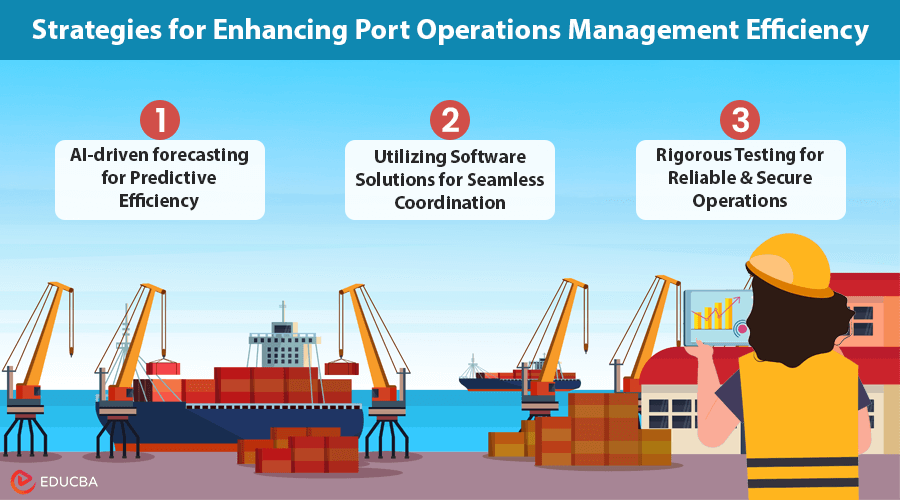Optimizing Port Operations
Ports are crucial hubs in the global economy, handling vast amounts of cargo and facilitating the seamless flow of goods. Enhancing port operations management has become more important in an increasingly complex and fast-paced logistics environment. Integrating modern technologies like artificial intelligence and robust testing mechanisms, ports can significantly improve operational efficiency and reliability. Strategic forecasting models and thorough testing practices allow ports to navigate the complexities of logistics, equipment management, and workforce coordination effectively, ensuring smooth and predictable operations.
Key Strategies for Enhancing Port Operations Management Efficiency
Optimizing port operations is crucial for maintaining the flow of goods and services. Let us explore ways to enhance operational efficiency and ensure seamless management in the complex port environment.
#1. AI-driven forecasting for Predictive Efficiency
Accurate forecasting is essential in any operation management, and in the case of ports, it becomes a significant factor in managing logistics, ship schedules, workforce allocation, and even environmental factors. AI Business Forecasting, powered by machine learning algorithms, processes historical data, real-time trends, and external factors to provide actionable insights. In a port environment, AI-based models can anticipate peak times, predict delays due to weather or congestion, and enable pre-emptive decision-making. This predictive insight allows management to allocate resources optimally, reducing downtime and avoiding costly inefficiencies.
Through AI forecasting, ports can also manage labor needs more effectively. For instance, during high-traffic periods, ports may require additional workforce deployment, while quieter periods might allow a reduced workforce presence. An AI-driven predictive system ensures that organizations use resources where and when they are most needed, enhancing operational efficiency.
#2. Utilizing Software Solutions for Seamless Coordination
Port operations management software has become indispensable for managing the complexities of port logistics and coordinating across various departments. These systems provide a centralized platform where data on container movements, ship schedules, equipment availability, and labor resources converge. By integrating data with predictive insights from AI forecasting, port management teams can make informed decisions aligning with short-term operational needs and long-term strategic goals.
Port operations software enhances coordination and provides a detailed overview of asset utilization and maintenance schedules. By tracking equipment health and usage patterns, the software helps reduce unexpected downtimes, thereby contributing to continuous operations. Furthermore, many of these platforms now incorporate real-time analytics, which keeps decision-makers informed and ready to adapt to rapidly changing conditions, such as sudden increases in shipping demand or equipment malfunctions.
#3. Rigorous Testing for Reliable and Secure Operations
Software glitches can lead to significant delays in high-stakes environments like ports, making rigorous testing essential to maintaining reliable operations. API Testing Services have become a critical component in validating the integration of various software systems. APIs facilitate the exchange of data across different platforms within the port’s operations, and by rigorously testing these APIs, port managers can ensure smooth communication between systems, minimizing the risk of failures.
API testing is also crucial for data accuracy and security. Ports often deal with sensitive information such as cargo details and shipping routes. Advanced testing protocols are crucial in securing data exchanges, safeguarding against unauthorized access, and ensuring compliance with industry standards. Furthermore, ongoing testing ensures that software systems can handle high-load situations, an essential factor given the fluctuating demands of port operations.
Integrating Forecasting, Software, and Testing
AI forecasting, advanced software solutions, and comprehensive testing are powerful combinations for enhancing port operations management. While forecasting enables proactive resource and workforce allocation, testing ensures that the underlying technology can handle the dynamic demands of port operations. By combining both, ports can minimize risks and respond swiftly to changing conditions.
For example, a port that uses AI forecasting to predict a surge in cargo volume during peak seasons can simultaneously conduct testing to ensure its software and APIs can handle the increased load.
This integrated approach guarantees that organizations effectively allocate resources while maintaining reliable and secure technological infrastructure under high demand.
Future Trends
The future of enhancing port operations management will likely see a deeper integration of AI-powered forecasting and automated testing solutions. Innovations in machine learning and predictive analytics will refine the accuracy of forecasts, possibly incorporating external data such as global economic indicators or geopolitical events. On the testing front, AI-driven testing tools will become more prevalent, enabling adaptive, real-time testing that adjusts to changing software and system demands.
Final Thoughts
Enhancing port operations management through AI-driven forecasting and comprehensive software testing is essential for meeting the demands of modern global trade. By leveraging these technologies, ports can improve operational efficiency, reduce costs, and increase reliability. Integrating these practices promises to take port operations to new heights as technology advances, benefiting both port operators and the global trade ecosystem.
Recommended Articles
We hope this guide on enhancing port operations management provides valuable insights into optimizing efficiency and ensuring smooth logistics in port activities. Check out these recommended articles for more strategies to improve port performance and management practices.



